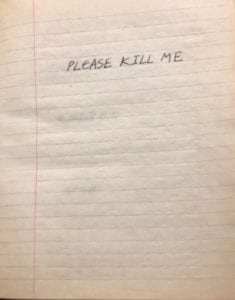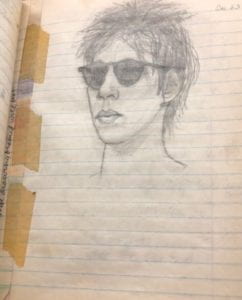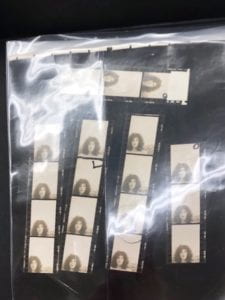
Max’s Kansas City
“The politics at Max’s were very similar to high school, except the popular people were not the cheerleaders or football heroes and the prom queen would most certainly be a he, dressed as a she, knowing more about being a she than most she’s…The back room, bathed in red light, was Robert’s objective, and the definitive target was the legendary round table that still harbored the rose-coloured aura of the absent silver king…They all seemed as if they were auditioning for a phantom, and that phantom was Andy Warhol.”
In her description of places like Max’s Kansas City, a popular nighttime artist hangout, Patti Smith explores the politics of the downtown art scene and also re-iterates why New York City, and the village in particular, is an unparalleled oasis, and destination, for aspiring artists. This concept of “auditioning for a phantom” is a kind of summation of what motivates so many to come to New York in order to pursue their artistic pretensions; there exists, throughout the city, the lingering presence of all those who have come before, and, with that, a hope in each young, aspiring artist that some of the greatness of these visionaries will rub off on them,
a phenomenon described by E.B. White in “This is New York” as well.
While every artist strives for the abstract goal of “getting in” with the luminaries of their time, the back room “bathed in red light” serves as a physical manifestation of this goal, of the unattainable inner circle. Despite the free-spiritedness of the bohemian culture, there still exists, within that supposed freedom, a desire to ascend certain social ladders and gain status and recognition. Her description of the politics of Max’s as akin to that of a high school, “except the popular people were not the cheerleaders or football heroes and the prom queen would most certainly be a he, dressed as a she” , reiterates the seemingly paradoxical sense of social hierarchy that dominates artists hangouts such as Max’s. Later, she writes, “things were picking up at Max’s. I stopped being so judgmental and got in the swings of things. Somehow I was accepted, though I never really fit in.” (pg. 129). These kinds of comments raise the question of precisely what it means to “fit in” with a crowd that places so much emphasis on individual self-expression and thus, ostensibly, should not be accepting of any one “type” of person and not another. For Patti Smith, Robert, and their friends, it is not only about making one’s art, but about observing and perhaps socializing with other artists, of being accepted by a greater community of individuals with similar aspirations. While these aspirations may be more lofty that of the popular kids at high school and thus, arguably, warrant the kind of hunger for acceptance that Patti observes in Robert during their time spent at Max’s, their world is nonetheless governed by certain forms of decorum and demand the intentional permeation of exclusive social circles.
This sense of exclusivity, too, applies not only to the relation of the “back room” to the rest of the restaurant also to the relation of Max’s to the world around it. Part of the city’s “Bermuda triangle” (pg. 116) of artist hangouts, these public spaces become implicitly private or exclusive, a concept which again seems contradictory to the free-spirited attitude of Patti and her contemporaries. While individuals at Max’s perhaps exhibit the same “pure freedom” that Patti does in Washington Square, this is not a place open to anyone, not a place to be observed by tourists, but rather a place to gather with other artists in the heart of the counter-culture movement.
Despite the aura of grandeur that permeates Max’s, and the coveted back room in particular, Patti Smith also notes the rampant drug use that fueled much of the creativity and artistic expression of the downtown punk scene. In reference to the host of future celebrities (Donald Lyons, Ondine, Rauschenberg, Dalí, Billy Name, Lichtenstein, Gerard Malanga, John Chamberlain) that presided over the coveted table at Max’s, she writes, “It was as darkly glamorous as one could wish for her. But running through the primary artery, the thing that ultimately accelerated their world and then took them down, was speed.” (pg. 117). In this moment, she nods to the darker elements of this seemingly carefree culture, and while she admires many of these artists, she also calls into question the extent to which they relied on drug use to inspire their artistic genius. While she suggests that much of their energy and stamina was a result of this drug use, she also notes that “amphetamine magnified their paranoia, robbed some of their innate powers, drained their confidence and ravaged their beauty.” (pg. 117). By inserting this comment about amphetamines into the vignette she paints of Max’s, Patti grants us insight into what is not readily apparent in a superficial description of the restaurant, and what was likely often forgotten by those who regularly visited Max’s at the time, Patti herself included.
The color red, which saturates Max’s – “everything, save the white walls, was red” (pg. 117) – also connotes both a sense of passion and energy as well as potential danger. The rosy glow through Patti, Robert and their other friends are seeing the goings-on at Max’s can be likened to the idea of “seeing the world through rose-colored glasses”, in that the red tones of the lighting and ambience serve as a kind of literal manifestation of the ways in which the sentiment of the idiom is exhibited in Patti Smith’s and others’ experience of Max’s; the excitement of being a part of this artistic community imbues one’s experience of Max’s with a certain haziness, a certain idealism or romanticism, that foregrounds the glamour and masks the darkness of this “darkly glamorous” scene.
Max’s Kansas City also serves as a platform for the performance of self in downtown NYC. In describing how she and Robert would get ready to go out, she writes that “Robert approached dressing like living art.” (pg. 118). For many of these artists, their persona – the version of themselves they display to the world – is as integral to their artistry as the formal artwork they produced. While the collaborative nature of the artist community allows for shared inspiration and , it also serves as a space in which individuals can validate their own identities. While the artist may be able to work in isolation, the artists in Patti Smith’s downtown counter-culture world are often equally concerned with their own identification as an artist and artistic “persona” as they are with the end product of their artistic processes. Patti Smith’s album cover, for example, is a showcase of her androgynous persona that was cultivated over time; it is through Robert’s photography that this persona is expressed to the world and, in a sense, validated. As these artists begin to form and actually create their own identities, they seek the company of others to present this identity to the world. Spots such as Max’s provide a space for these artists to come together, to be observed and watched by others, and to take note of the myriad other identities that exist in this world.
As Robert Hell writes in his journal (quoting Paul Bowles), “for the first time I was made aware that a human being is not one entity and that his interpretation of exterior phenomena is meaningless unless it is shared by the other members of his cultural group.” This desire, perhaps this need, to be amongst others who, in some way, share one’s perception of the world can be understood as an explanation for why Max’s Kansas City was such a prized and popular location.
While this acknowledgement of a shared or collective way of seeing the world is seemingly antithetical to the counter-culture’s prioritization of an individual’s unique subjectivity, these artists were perhaps less unified by an identical “interpretation of exterior phenomena” but by a shared desire to communicate their unique subjectivity/ “interpretation of exterior phenomena” to the world through their art. In this way, they did not share a subjectivity but rather a hankering to express their individual subjectivity. Unlike Hotel Chelsea, Max’s was not a site for collective art-making; it was a place sense in which artists sought camaraderie and validation in a city that can be extremely lonely if on one’s own. While the socialization that took place at Max’s is, at least on the surface, markedly different than our traditional sense of “networking” in the contemporary professional world, the restaurant still functioned as a site for making connections with individuals who shared one’s aspirations and could grant them further access to the formal institutions of the artistic world, i.e. galleries, studios, record labels.
Despite their defiance of traditional norms, those who considered themselves a part of the counter-culture were not entirely separate from or immune to the conventions of the “mainstream” culture, and this contradiction is perhaps made most blatant in Patti’s descriptions of Max’s than it is anywhere else in Just Kids.
Richard Hell journal
In 1974, Patti Smith gave fellow punk pioneer Richard Hell a journal. She had already filled its first pages with musings and poems, and in the years following, Hell dutifully filled the rest. The journal is now a primary source document that encapsulates the seventies art scene as seen by a prominent New York-based punk artist.
That the journal was shared demonstrates a key feature of the time period: the collaboration between counterculture artists in the Village. In his first entry, Hell writes that the notebook is “utterly useless” to him because he prefers to “write on a typewriter,” but that he will “figure out some systematic way to fill it up” anyway because it was a gift. Pondering this, he decides he can “always read the preceding pages,” written by Patti Smith, “for inspiration.” In even the most casual of ways, Hell invokes the power of following another artist’s lead to create better art, something the artists of downtown New York, living and working in close communities, were often able to do.
One way Hell does end up filling pages is by writing down personally meaningful quotes, including this one, from author Paul Bowles’ autobiography Without Stopping, on Christmas Day, 1974: “Here for the first time I was made aware that a human being is not one entity and that his interpretation of exterior phenomena is meaningless unless it is shared by the other members of his cultural group.” While it’s impossible to say for sure why Hell chose this quote, it may have resonated with him because of his experiences on the collaborative 1970’s New York art scene. Artists, by trade, are always in the process of producing an “interpretation of exterior phenomena;” they observe the world around them and translate those observations into art. And in this era, all of those observations were “shared by the other members” of the artist’s “cultural group” in spaces like the Chelsea Hotel, CBGB, and Max’s Kansas City. Being an artist was as much about being with and known by other artists as it was about producing art pieces, and what Hell chose to include in his journal exemplifies this, whether deliberately or not.
Another prominent feature in Hell’s writing — corresponding to its prominence in the culture of the seventies — is drugs. As Hell says in a December 1978 entry, “I can’t seem to resist altering myself at the slightest sign of boredom or dissatisfaction.” He dryly acknowledges the pattern between his journal writing and his drug use, writing in an October 1976 entry that it “seems like 90% of the times I write in here I’m high or else it’s a girl.” On November 1976, he shares a commitment to “always specify it when” he’s on drugs and puts “more than a couple of lines in this book.” And because he keeps his word, it is clear that a significant amount of the journal was fueled by drugs. Entries start with “(more coke),” “having just consumed another dose of speed,” and “I’m writing now because I just shot a little cocaine.”
In Just Kids, Smith writes that while she was not interested in drugs, Robert Mapplethorpe used them regularly; they formed a central part of his artistic process. In fact, one of the first descriptions of Robert is after he has “dropped acid” and is “arranging his drawing pad and pencils” so he can have “his tools by him in case” he must use them to capture a vision (Smith 20). Once the drug takes effect, he can “see the work” on the paper, even though he has “not yet drawn” anything (Smith 21). His creative dependence on drugs is common among artists of the seventies; the crown jewel of the art scene, Max’s Kansas City, is a “darkly glamorous” world where “running through the primary artery” is always amphetamine (Smith 117).
Hell seems to share Mapplethorpe’s belief about the connection between drugs and creativity — or, at the very least, Hell values his art so highly that it overshadows his addiction struggles. In one October entry, he writes about his heroin addiction, including that he “O.D.’d today” and feels “lousy” — but without so much as a paragraph break, he goes into planning his band’s name and its debut at CBGB. In matters of life or death, it seems, life’s victory is only relevant because it is a necessary condition for art. Perhaps Hell’s nonchalance about the overdose also demonstrates the degree to which drugs were ingrained in the culture; an overdose seems commonplace, earning only a passing mention, no more emphasized than a conversation had or a movie seen.
But while Hell does equate drugs with productivity—at the very least in the context of his journaling—he also subverts the notion that the best art comes from drugs. On December 7, 1978, he writes that “for the first time in three years,” he is “completely independent of drugs,” with “no addiction.” This, it turns out, proves to him that not only do drugs fail to positively affect art, they actively harm it. In a later entry, he writes that his singing voice “unaffected by narcotics” is “much richer in tone, more flexible,” with “much greater a range than ever before.” His “vocal artistry and stage presence” have “improved so dramatically” after getting clean that he says listeners must assume he has suddenly acquired “grace from heaven.” Reflecting on his years “buried in sleepwalk of [his] addiction,” he asks if his “fairly interesting and extensive” experiences during that time “were of any value.” By rejecting — even temporarily, because Hell does go back to using drugs later in the notebook — the idea that drugs are a sacred and mostly harmless avenue for creation, Hell’s writing breaks with its time. In this respect, he is more like Smith — or perhaps more like Smith’s retrospective narration, where she writes that speed “robbed some” artists “of their innate powers” and “drained their beauty” (Smith 117).
Overall, the once-private musings of an artist documenting his creative strategies and personal neuroses has become a valuable lens through which the world can view a bygone era.



